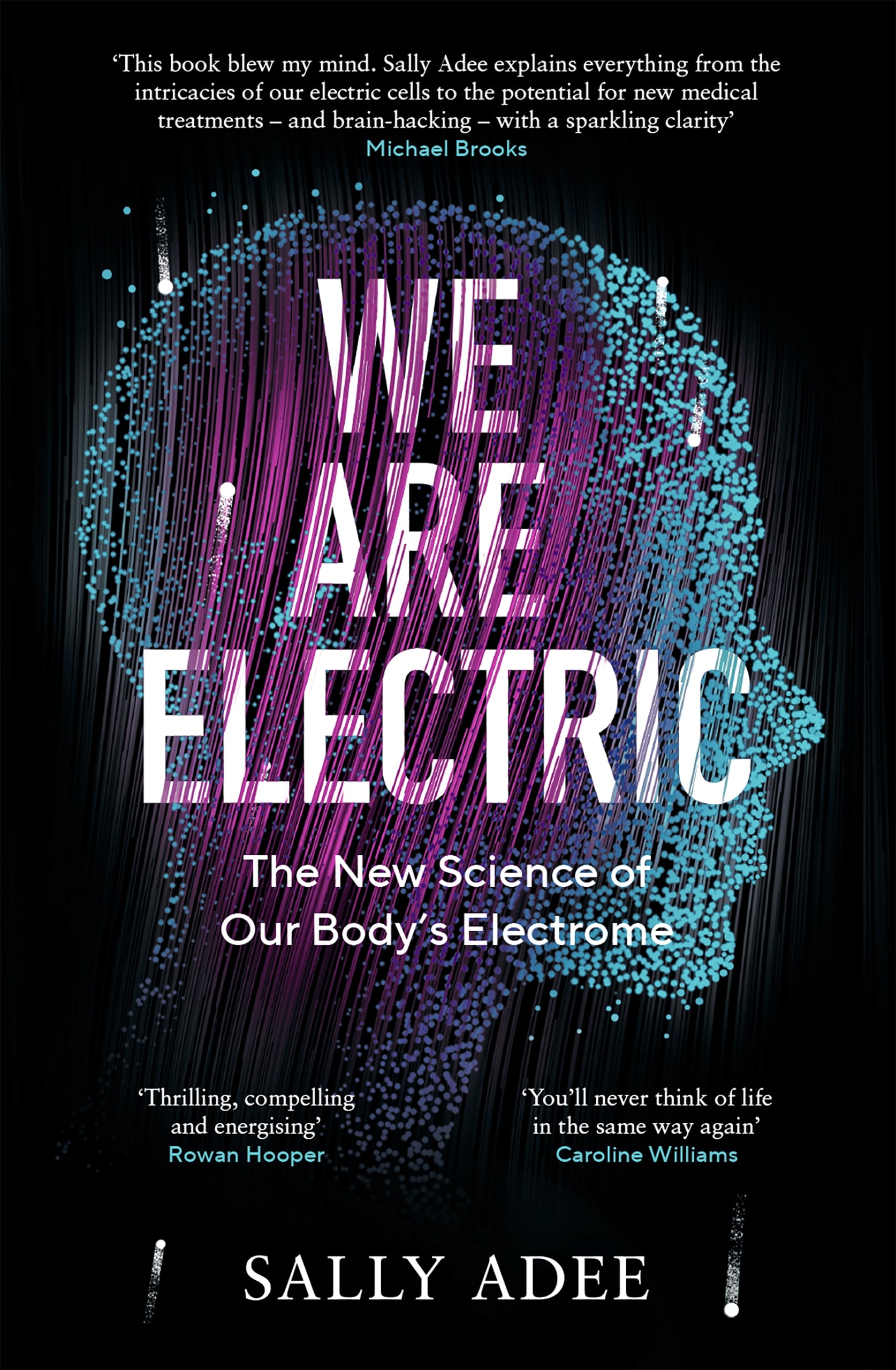Sally Adee: We Are Electric review - currents that run through us all | reviews, news & interviews
Sally Adee: We Are Electric review - currents that run through us all
Sally Adee: We Are Electric review - currents that run through us all
A buzzing appraisal of a scientific revolution

All the things going on with me as I type this – fingers moving keys, eye and brain registering characters on my screen, thoughts that will (I hope) generate the next lot of characters – rely on electrical signals.
So much has been common knowledge since scientists built clever enough detectors to show nerve impulses, and brain waves. And electrical technology has been applied, with more enthusiasm than finesse, in procedures like electroencephalography (EEG), reading the waves, and electroconvulsive therapy (ECT), giving them a good thrashing.
But they are many decades old, and today we realise there is vastly more to know about how electricity influences the nervous system, and all our other tissues. As those more subtle cellular whispers are teased out in the lab, Sally Adee suggests, they will usher in a new biomedical era in which electrical cures, and enhancements, will be among the defining advances of the 21st century.
 Adee, a former technology watcher for New Scientist, has put together an admirably comprehensive and clear look at electrical life, past, present and future. She takes us from the first twitching of frogs’ legs dissected by Luigi Galvani in the 18th century, when electricity itself was still mysterious and magical, to modern bio-labs where molecular-scale observation reveals the working of delicately regulated ion channels in the membranes that border single cells.
Adee, a former technology watcher for New Scientist, has put together an admirably comprehensive and clear look at electrical life, past, present and future. She takes us from the first twitching of frogs’ legs dissected by Luigi Galvani in the 18th century, when electricity itself was still mysterious and magical, to modern bio-labs where molecular-scale observation reveals the working of delicately regulated ion channels in the membranes that border single cells.
Putting it like that highlights two crucial features of the new electroscape. First, it is lit up, mainly, not by the kind of electricity that courses through the wiring in your home (a current of negatively charged electrons), but by currents and voltages that typically involve positive ions (atoms stripped of an electron or two). Second, cells – not just nerve cells, but all cells – micromanage the movement of ions across their boundaries, using a highly evolved suite of gates, sluices and pumps that choose which ones can pass, under exactly what conditions.
That leads to myriad small events with powerful consequences. The electrical waft in and out of a cell may be a hundred thousand millionth of the current that powers your toaster, Adee notes. On the other hand, while a cell regulates ion concentrations so that there may be a voltage difference between inside and outside of just 70 millivolts, the cell membrane is only a few nanometres across. The matching voltage on the scale of a whole human would be 10 million volts.
Down among the cells again, the result is that electrical influences are powerful, and ubiquitous. If we can map them, we will have a new understanding of tissues, organs and bodies so important that it deserves a name that puts it on a par with the complete sequence of our DNA, the genome - hence the electrome. It emerges a little hazily from Adee’s account, a parallel communication and control system, working alongside genes, hormones and the immune system, and interacting with all of them, from embryonic development to death. Bringing it fully into view should give us a better handle on a host of disorders, including cancer, allow us to induce tissue regeneration when organs are damaged, and maybe even enhance our memory and cognition.
But not quite yet. For all the advances exposing parts of this wondrous system, Adee has to tread carefully between hype, boosted by magical thinking that still seems to attach itself to electricity, and honesty about what we actually understand. She is hopeful, but determinedly realistic. For example, there’s a balanced discussion of deep brain stimulation, in which implanted electrodes are used to produce a variety of effects, including, on occasion, improvements in conditions like Parkinson’s disease, depression, and obsessive compulsive disorder. But, she concludes, “no-one is sure exactly how DBS works”. It remains, as one researcher puts it, like playing the piano with a mallet. Later, Adee emphasises that the study of brain stimulation is not broken, “it’s just really, really hard, like science in general.”
Speaking of hard things, this must have been a taxing book to write. A developing field that gets lots of press attention means an author must keep track of the good studies along with the bad, decide when to call bullshit on overblown claims, all the while building a narrative that gives a fair idea of its historical roots, envisages how it might progress, and explains complex ideas from physiology, cell biology, and neuroscience.
Adee remains impressively surefooted while balancing all these demands. Her history gets a little over-excited at times, but her patience in explanation makes up for it. Her elaboration of a notion taken from the physiologist Frances Ashcroft – that ion channels work rather like bouncers regulating guest access to a nightclub – grows into one of the nicest accounts of a neuron’s action potential you will find.
Add some enterprising personal reporting, and a slew of good stories – respect to the researcher so desperate to get data for the US Food and Drug Administration about his implant he had it surgically installed in his own brain by a compliant neurosurgeon in Belize – and the result is entirely readable. Doubts may linger about some of the theoretical language, like the electrome. It gets tied into metaphors of cybernetic control and coding that have permeated molecular biology since the DNA helix was solved seventy years ago, but not in a way that’s entirely coherent. At one point the idea that the electrome, whatever it is, is essentially informational, leads Adee to refer to ion flows as software and the genes in the cell as hardware, a curious inversion of how they are usually thought of these days.
So this careful look at a burgeoning field also indicates that it will need some conceptual breakthroughs, as well as continued improvements in finely tuned instrumentation, to develop. But develop it surely will, and I hope Adee sticks with it to produce the second edition her subject will call for in a few years time.
- We Are Electric: The New Science of Our Body’s Electrome by Sally Adee (Canongate, £20)
- Book reviews on theartsdesk
The future of Arts Journalism
You can stop theartsdesk.com closing!
We urgently need financing to survive. Our fundraising drive has thus far raised £49,000 but we need to reach £100,000 or we will be forced to close. Please contribute here: https://gofund.me/c3f6033d
And if you can forward this information to anyone who might assist, we’d be grateful.

Subscribe to theartsdesk.com
Thank you for continuing to read our work on theartsdesk.com. For unlimited access to every article in its entirety, including our archive of more than 15,000 pieces, we're asking for £5 per month or £40 per year. We feel it's a very good deal, and hope you do too.
To take a subscription now simply click here.
And if you're looking for that extra gift for a friend or family member, why not treat them to a theartsdesk.com gift subscription?
more Books
 'We are bowled over!' Thank you for your messages of love and support
Much-appreciated words of commendation from readers and the cultural community
'We are bowled over!' Thank you for your messages of love and support
Much-appreciated words of commendation from readers and the cultural community
 Thomas Pynchon - Shadow Ticket review - pulp diction
Thomas Pynchon's latest (and possibly last) book is fun - for a while
Thomas Pynchon - Shadow Ticket review - pulp diction
Thomas Pynchon's latest (and possibly last) book is fun - for a while
 Justin Lewis: Into the Groove review - fun and fact-filled trip through Eighties pop
Month by month journey through a decade gives insights into ordinary people’s lives
Justin Lewis: Into the Groove review - fun and fact-filled trip through Eighties pop
Month by month journey through a decade gives insights into ordinary people’s lives
 Joanna Pocock: Greyhound review - on the road again
A writer retraces her steps to furrow a deeper path through modern America
Joanna Pocock: Greyhound review - on the road again
A writer retraces her steps to furrow a deeper path through modern America
 Mark Hussey: Mrs Dalloway - Biography of a Novel review - echoes across crises
On the centenary of the work's publication an insightful book shows its prescience
Mark Hussey: Mrs Dalloway - Biography of a Novel review - echoes across crises
On the centenary of the work's publication an insightful book shows its prescience
 Frances Wilson: Electric Spark - The Enigma of Muriel Spark review - the matter of fact
Frances Wilson employs her full artistic power to keep pace with Spark’s fantastic and fugitive life
Frances Wilson: Electric Spark - The Enigma of Muriel Spark review - the matter of fact
Frances Wilson employs her full artistic power to keep pace with Spark’s fantastic and fugitive life
 Elizabeth Alker: Everything We Do is Music review - Prokofiev goes pop
A compelling journey into a surprising musical kinship
Elizabeth Alker: Everything We Do is Music review - Prokofiev goes pop
A compelling journey into a surprising musical kinship
 Natalia Ginzburg: The City and the House review - a dying art
Dick Davis renders this analogue love-letter in polyphonic English
Natalia Ginzburg: The City and the House review - a dying art
Dick Davis renders this analogue love-letter in polyphonic English
 Tom Raworth: Cancer review - truthfulness
A 'lost' book reconfirms Raworth’s legacy as one of the great lyric poets
Tom Raworth: Cancer review - truthfulness
A 'lost' book reconfirms Raworth’s legacy as one of the great lyric poets
 Ian Leslie: John and Paul - A Love Story in Songs review - help!
Ian Leslie loses himself in amateur psychology, and fatally misreads The Beatles
Ian Leslie: John and Paul - A Love Story in Songs review - help!
Ian Leslie loses himself in amateur psychology, and fatally misreads The Beatles
 Samuel Arbesman: The Magic of Code review - the spark ages
A wide-eyed take on our digital world can’t quite dispel the dangers
Samuel Arbesman: The Magic of Code review - the spark ages
A wide-eyed take on our digital world can’t quite dispel the dangers
 Zsuzsanna Gahse: Mountainish review - seeking refuge
Notes on danger and dialogue in the shadow of the Swiss Alps
Zsuzsanna Gahse: Mountainish review - seeking refuge
Notes on danger and dialogue in the shadow of the Swiss Alps

Add comment